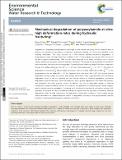| dc.contributor.author | Xiong, Boya | |
| dc.contributor.author | Purswani, Prakash | |
| dc.contributor.author | Pawlik, Taylor | |
| dc.contributor.author | Samineni, Laxmicharan | |
| dc.contributor.author | Karpyn, Zuleima T. | |
| dc.contributor.author | Zydney, Andrew L. | |
| dc.contributor.author | Kumar, Manish | |
| dc.date.accessioned | 2020-01-22T13:29:32Z | |
| dc.date.available | 2020-01-22T13:29:32Z | |
| dc.date.issued | 2020-01 | |
| dc.date.submitted | 2019-06 | |
| dc.identifier.issn | 2053-1400 | |
| dc.identifier.issn | 2053-1419 | |
| dc.identifier.uri | https://hdl.handle.net/1721.1/123517 | |
| dc.description.abstract | Degradation of drag reducer polyacrylamide under high volume hydraulic fracturing (HVHF) conditions alters its
polymer size, distribution and chemical composition, potentially affecting the toxicity and treatability of the
resulting wastewater. This study focused on a non-chemical pathway-mechanical degradation of
polyacrylamide under ultra-high fluid strain conditions (∼10[superscript 7] s[superscript −1]) that uniquely exist during HVHF but has not
yet been explored experimentally. PAM solutions were subjected to an abrupt contraction into a narrow
capillary driven by a high-pressure precision pump (∼10 000 psi). The change in polyacrylamide size distribution
was evaluated by size exclusion chromatography. The peak polymer molecular weight (MW) after a single-pass
through the capillary decreased from 10[superscript 7] to 7 × 10[superscript 5] Da at deformation rate V/R = 4 × 10[superscript 6] s[superscript −1]. The extent of degradation increased with V/R, approximately following an empirical scaling relationship of MW ∝ V[superscript −0:69]/R for the
polyacrylamide with an initial MW ≈ 10[superscript 7] Da. Degraded PAM with lower MW (<10[superscript 6] Da) showed minimal
degradation during multiple flow passes even at high deformation rates, suggesting that most mechanical
degradation occurs at the first entrance into the fracture. Relative to chemical degradation, mechanical
degradation caused a narrowing of the MW distribution due to greater degradation of the larger MW polymers
and preferential mid-chain polymer scission. In addition, we saw no detectable change in chemical
composition during mechanical scission, in contrast to the generation of carbonyl groups during oxygenic
radical induced chemical degradation. Combining both chemical and mechanical mechanisms during HVHF
operation, we propose an initial mechanical breakage of polymer chain by fluid strain, followed by chemical
degradation under the high temperature and appropriate mineralogical conditions. These findings provide
critical information for understanding the nature of degradation byproducts from polyacrylamide, and the
treatability of polyacrylamide fragment-containing wastewaters. | en_US |
| dc.publisher | Royal Society of Chemistry (RSC) | en_US |
| dc.relation.isversionof | http://dx.doi.org/10.1039/c9ew00530g | en_US |
| dc.rights | Creative Commons Attribution Noncommercial 3.0 unported license | en_US |
| dc.rights.uri | https://creativecommons.org/licenses/by-nc/3.0/ | en_US |
| dc.source | Royal Society of Chemistry (RSC) | en_US |
| dc.subject | Environmental Engineering | en_US |
| dc.subject | Water Science and Technology | en_US |
| dc.title | Mechanical degradation of polyacrylamide at ultra high deformation rates during hydraulic fracturing | en_US |
| dc.type | Article | en_US |
| dc.identifier.citation | Xiong, Boya et al. "Mechanical degradation of polyacrylamide at ultra high deformation rates during hydraulic fracturing." Environmental Science: Water Research & Technology 6, 1 (January 2020): 166-172 © 2020 The Royal Society of Chemistry | en_US |
| dc.contributor.department | Massachusetts Institute of Technology. Department of Civil and Environmental Engineering | en_US |
| dc.relation.journal | Environmental Science: Water Research & Technology | en_US |
| dc.eprint.version | Final published version | en_US |
| dc.type.uri | http://purl.org/eprint/type/JournalArticle | en_US |
| eprint.status | http://purl.org/eprint/status/PeerReviewed | en_US |
| dspace.date.submission | 2019-12-13T14:37:47Z | |
| mit.journal.volume | 6 | en_US |
| mit.journal.issue | 1 | en_US |
| mit.metadata.status | Complete | |
